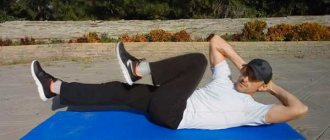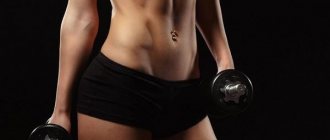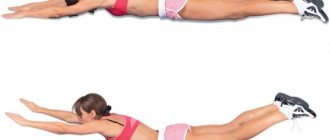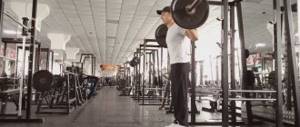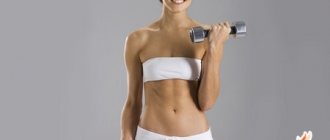It’s clear that everyone wants to have great abs. The main distinguishing feature of any bodybuilder is a narrow waist, as it creates a number of advantages, including, first of all, appearance, since the width of the shoulders can be emphasized due to a narrow waist.
In order to know how to work with the press, you first need to know its anatomy. The press is the surface of the abdomen, which is a rectus muscle on which straight lines of tendons intersect, which are commonly called six “packs”. The press begins under the ribs and ends in the groin area. It should be noted that at the edges of the rectus muscle there are paired oblique muscles. However, when pumping up your abs, you need to understand that the rectus muscle and the paired oblique muscles have completely different functions. When the rectus muscle contracts, the body folds like a penknife, and in the case when the oblique muscles work, the body rotates in different directions. It is impossible to strain the rectus and oblique muscles at the same time, since when twisting the body, the oblique muscles are tensed statically, while the body itself is fixed horizontally. Thus, pumping the press with additional loads
, is strictly not recommended, as in this case, the waist may expand. On the other hand, sports medical experts do not agree with this statement. According to them, the muscles of the lower back, together with the abs, form the so-called muscle corset of the waist. When performing exercises such as deadlifts, as well as various back stretching exercises, the muscular corset of the waist performs a stabilizing function. In order to be able to perform this kind of exercise, you need a strong abs in any case. Therefore, it is not surprising that a person with weak abs is quite far from an ideal athletic figure. Thus, many, out of ignorance, make the mistake of pumping up their abs to the point of exhaustion, but without additional weights. This ultimately only inhibits the growth of muscle mass.
If we talk about how to properly pump up the abs with a load, it should be noted that the waist can expand only if, using additional weights, you do a set of exercises with a large number of repetitions. In order to give your abs strength, you must first do ab exercises with a low number of repetitions. The same principle works here as in other muscle groups: if you want to increase strength, work hard, but with a small number of repetitions; If you want to increase muscle volume, do an average number of repetitions.
Therefore, you don’t need to listen to various “gurus” who say that pumping up your abs with additional weights is harmful. This must be done, but everything must be done correctly. It is recommended to perform six to eight really heavy repetitions in a set of weighted abdominal exercises. This is how you can develop true abdominal strength. Also, do not forget that it is better to start pumping up your abs with strength exercises. And then you can begin multi-repetition sets of abdominal exercises to achieve relief and endurance.
However, you need to know that you can work out your abs until you’re blue in the face, but this will have very little effect on the fat layer on top of it. After all, to burn fat, it is most effective to give the body aerobic exercise coupled with following a certain diet. Well, it is also highly recommended to take appropriate sports nutrition.
Your complete guide to ab exercises.
All athletes, whether hockey players, baseball players or football players, strengthen their abdominal muscles by performing basic exercises. This is great for professional athletes, but what about the guys and gals who just want to tone their abs and see that coveted 6-pack? How can they find the most effective abdominal exercises to see six-pack abs? Or maybe the secret to a flat stomach lies elsewhere?
First, let's face it: everyone's abdominal muscle structure is different, and most importantly, everyone's amount of subcutaneous fat and metabolism are different. Some guys have to work out to the point of exhaustion before their abs become ripped, while others seem to have a six-pack appearing without much effort.
Regardless of which group you belong to, effective abdominal exercises for training in the gym or at home come down to movements in three planes: frontal, sagittal and transverse. By doing abdominal exercises in cycles, you'll keep your workout intensity high and are likely to burn more fat.
Ready to train your abdominal muscles? Let these 30 ab exercises at home and in the gym serve as the best workout guide you've ever encountered.
Roll-outs with a gymnastic roller
Get on your knees and hold the roller on the floor directly under your shoulders. Tighten your abdominal muscles and roll the roller forward until you feel tension in your core muscles. The hips should not sag. Roll the roller back to return to its original position. Do as many repetitions as possible, maintaining the correct technique for performing the exercise.
Partial torso raises with raised arms
Lie on your back, bend your legs at an angle of 90°, straighten your arms and lift them up. Keep your arms in this position throughout the entire exercise. Perform a partial lift of the torso, and then slowly return to the starting position. These movements constitute one repetition.
Rollouts with a barbell
Place 5kg weight plates on the bar and kneel down. Shoulders should be above the bar. Tighten your abdominal muscles and roll the barbell forward until you feel your hips begin to sag. Return to the starting position.
Russian twist with barbell
Grasp the bar with both hands almost at the very end. Feet shoulder width apart. Rotate the bar to the left, moving your feet as necessary, and then rotate to the right.
Crunches on a fitball
Lie with your back on the ball, place your feet on the floor and place them shoulder-width apart. The ball should support your lower back. Place your hands behind your head, pull your chin back. Lift your torso up until you are in a sitting position.
Leg raises on parallel bars
Take an emphasis on the uneven bars. Bend your knees slightly and then lift them in front of you until they are parallel to the floor.
Lying leg raise
Lie on your back, straighten your legs, place your arms along your body. Lift your heels off the floor and lift them to a height of about 15 cm. At a fast pace, alternately lift your legs up and down (scissor style).
Front Squats
Place the barbell on a power rack at approximately shoulder height (if there is no power rack, then grab the barbell from the floor to your chest). Grasp the bar with a shoulder-width grip. Raise your elbows up until your shoulders are parallel to the floor. Remove the barbell from the racks and support it with your fingertips. As long as your elbows are raised, you will be able to hold the barbell. Take a step back, place your feet shoulder-width apart, and point your toes slightly outward. Squat down as low as possible, maintaining a arch in your lower back.
Lumberjack exercise
Place the handle of the machine at shoulder height (or attach the resistance band to a stable object) and grasp it with both hands. Stand with your side to the handle, spread your feet shoulder-width apart, straighten your arms. Stand far enough away from the machine to create tension in the cable. Turn your body away from the machine in a movement as if you were cutting down a tree. The legs must remain motionless.
Lying leg raise
Lie on the floor and grab a bench or the legs of a heavy chair for support. Straighten your legs and lift them up to a vertical position. Lower your legs down, but don't place them on the floor, to maintain tension in your abdominal muscles before starting the next rep.
Russian twist with medicine ball
Sit on the floor holding the medicine ball with both hands. Straighten your arms in front of you. Explosively twist your torso to the side and then return to the starting position. Make a similar movement in the other direction.
“Running” while lying down with a medicine ball
Get into a lying position supported by a medicine ball. Bring one knee toward your chest and then quickly move it back while bringing the other knee toward your chest.
"Superman"
Take a lying position with your toes on the fitball. Bend your body in half, rolling the ball toward you with your feet until your torso is upright. Roll the ball back until your body is straight again. Then place your shins on the exercise ball so that your body is in a straight line and your outstretched arms are above your head but still on the floor. The body position should resemble Superman flying down. These movements constitute one repetition. Tightening your back muscles, return to the starting position (lying up) and begin the next repetition.
Plank
Take a lying position, bend your elbows so that your forearms are on the floor. Tighten your abdominal muscles and hold this position.
Pull-ups with knee raises
Hang from the horizontal bar using an overhand grip. Place your hands shoulder-width apart. Pull yourself up until your chin is over the bar, then lift your knees toward your chest.
Push-ups with cotton
Get into a prone position with your feet in the handles of the suspension training straps. Push off the floor so that you can clap your hands in the air.
Reverse crunches with an expander
Lie on your back and place the resistance band around your feet. Cross the ends of the resistance band so that they form the letter “X” and grab the opposite ends of the band with your hands. Bend your legs so that your knees are close to your chest, and then lift your torso off the floor. Straighten your legs while moving your arms back behind your head. Shoulder blades should not touch the floor. These movements constitute one repetition.
Rollouts with fitball
Place your forearms on the fitball, take your legs back and straighten. Tightening your abdominal muscles, roll the fitball forward until your arms are straight. When you feel that your abdominal muscles are no longer tense, return to the starting position by rolling the exercise ball back.
Try others for training at home.
Leg raises while sitting on a bench
Sit on a bench and hold a medicine ball between your feet. Straighten and raise your legs in front of you. Pull your torso back so that your body is straight in line. Hold on to the bench to maintain your body position. Lift your torso up and bring your knees to your chest.
Side plank
Lie on your left side, place your left forearm on the floor. Raise your hips so that your body is in a straight line. Tighten your abdominal muscles. You should rest on your left forearm and the edge of your left foot. Hold this position, tensing your abdominal muscles.
"Sprinter"
Get into a prone position with your feet in the handles of the suspension training straps. Bring your right knee toward your chest while keeping your left leg straight. Now take your right leg back while bringing your left knee towards your chest. The movements should resemble running.
Raising the body with a ball throw
Sit on the floor, hold the ball with both hands at chest level. Place your feet under a heavy object to maintain proper body position. Lie with your back on the floor a few tens of centimeters from a brick or concrete wall. With an explosive movement, lift your torso, throw the ball at the wall, and then catch it on the rebound. If you have a partner, you can throw the ball to each other.
Bar in star position
Take a lying position. Spread your arms and legs as wide as possible. Your body should take the shape of a star. Tighten your abdominal muscles and hold your body straight for 30 seconds.
Raising the torso with a barbell
Lie down on the floor. Hold an empty or lightly loaded bar over your shoulders, as if doing a bench press. Straighten your legs and place them on the floor. Raise your torso to a vertical position. Hold the bar overhead as if doing a military press.
Place a barbell on the floor to your right and place your feet hip-width apart. Push your hips back, squat down, and grab the center of the bar with your right hand. Tighten your core muscles. Keeping a slight arch in your lower back, push your heels off the floor to stand. Hold the barbell tightly so that the apparatus does not swing. Make sure to keep your spine straight throughout the exercise. Do not lean towards the bar.
Plank with circular movements
Place the fitball on the floor and lie down with your support on it. Place your forearms on the exercise ball, keeping your body straight and keeping your abdominal muscles tight. Using your elbows, rotate the exercise ball in a circular motion, first clockwise, then counterclockwise.
V-shaped torso lifts with fitball
Lie with your back on the floor. Hold the exercise ball between your ankles. Stretch your arms behind your head. As you lift your legs, simultaneously lift your torso and take the fitball in your hands. Lower your torso to the floor and repeat the movements, lifting the exercise ball and holding it again between your ankles.
V-lifts with medicine ball
Lie on your back on the floor, holding the medicine ball behind your head with both hands. Straighten your legs. Tighten your abdominal muscles. At the same time, raise your legs and reach your toes with the medicine ball. Your body should be in a "V" shape during this phase of the exercise.
Raising the torso with weights
Lie on the floor and hold a weight plate against your chest. Bend your knees at an angle of 90°, but so that the entire surface of your feet remains on the floor. Keep your chin at chest level throughout the exercise.
Lumberjack exercise while standing on one knee
Lower yourself into a deep lunge position with your left leg forward. Reach over your left shoulder to the handle of the expander. Pull the handle diagonally down across your body toward the outside of your right thigh.
Sooner or later there comes a time when the previous training method ceases to produce results. This is where weight training comes to the rescue.
Abdominal exercises with weights will increase the load on your abdominal muscles, making them even stronger.
Dumbbells, barbell plates, or simply heavy objects that are comfortable to hold in your hands are suitable as an additional weight element.
How to do
It is not at all necessary to do a dozen exercises at high speed and with a large number of repetitions. The technique of execution has a great influence on the result of training. However, the lesson program also plays an equally important role. It is enough to include 3-5 basic exercises aimed at developing various muscle groups in the abdominal region. Who are abdominal exercises with weights suitable for? First of all, people whose muscles are difficult to develop should pay attention to training with additional weight.
It is especially difficult due to the genetic characteristics of the female body, so many of them often use dumbbells to work the abs. In addition, weights should be used when it is necessary to increase the volume of the abs. It should be remembered that when performing abdominal exercises with weights, it is necessary to reduce the number of repetitions to 10-12 per approach. Consider some effective abdominal exercises performed with additional weight.
Crunches
Classic ones can be performed with weights. However, if you need to achieve not just strong, but also sculpted abs, then use double twisting:
- Lie on your back with your knees bent;
- Squeeze a heavy ball or book between your knees, and take a dumbbell or barbell in your hands;
- With one effort, pull your knees toward your chest, twisting your torso.
- For this weighted abdominal exercise, use an additional weight of no more than 5 kg.
The following video shows another variation of dumbbell crunches:
Tilts to the side
Side bends with dumbbells are great for strengthening your sides and obliques. They are quite simple to do:
- Place your feet shoulder-width apart and take a dumbbell in your right hand and place your left hand on your belt;
- Lower yourself down with the right side of your body, allowing the projectile to pull you down;
- Slowly return to the starting position and bend in the other direction.
Leg raises
To perform this weighted ab exercise, you will need weights that can be attached to your ankles. During movement, the problematic part of the abdominal press itself, the lower abdomen, is actively worked out.
Do you want to pump up your abs? To do this, you will need an effective abdominal exercise and a suitable diet. Crunches are the most popular abdominal exercise.
It is simple and yet very effective. With its help, you can pump up your abs, tighten your stomach, and speed up fat burning. To perform it in the classic version, you do not need any additional equipment, exercise equipment, or a lot of free space.
- herniated intervertebral discs;
- osteoporosis;
- osteochondrosis;
- heart problems;
- problems with the respiratory system.
Ab exercises with weights
Sooner or later there comes a time when the previous training method ceases to produce results.
This is where weight training comes to the rescue. Abdominal exercises with weights will increase the load on your abdominal muscles, making them even stronger.
Dumbbells, barbell plates, or simply heavy objects that are comfortable to hold in your hands are suitable as an additional weight element.
Execution options
In the classic version, the exercise is performed lying on the floor on a gymnastic mat or on a horizontal bench with your knees bent. In addition to this method, there are many other options:
| View | Short description |
| On an incline bench | Allows you to work out the lower zone of the rectus muscle well. To do this, you need to sit on the bench in such a way that your head is lower than your feet. Also, with this method, it is more difficult to lift the body, which means the muscles receive more stress. |
| On fitball | Performed similarly to crunches while lying on the floor. In this case, your back lies on a gymnastic ball, and your feet are on the floor. At the moment of lowering the body, you can stretch it well, thereby increasing the range of movements |
| With your feet up | It is performed lying on a horizontal plane, similar to classic crunches, the only difference is that the legs must be kept suspended during the entire approach. To do this, they need to be bent 90 degrees at both the knee and hip joints, so that the thighs end up vertical and the shins horizontal. |
| With weights | Suitable for those who need a heavy load. A barbell plate or dumbbell of suitable weight is usually used as a load. |
| On a vertical block | You need to take the handle of the simulator, kneel in front of it and begin to flex and extend your body. At the moment of maximum contraction of the abdominal muscles, the hands should be at the back of the head, when extending the body - above the forehead |
| In a special simulator for working out the abs | Another good option for those who work out in the gym. Exercises in the simulator also allow you to adjust the load, and the mechanism is designed in such a way that it is quite difficult to perform the exercise with the wrong technique. This means that the press will receive a good load in any case, so the option is great for beginners. There are simulators for horizontal and vertical twisting, that is, for training in a lying and sitting position, respectively. They differ slightly in the nature of the load |
| Oblique crunches | During lifting, the body rotates around the axis of the body. If your hands are located behind your head, your elbow should first touch your right knee, then your left knee. If your arms are crossed over your chest, your elbows should reach toward your upper thighs. This version of the exercise allows you to well load the oblique muscles. Whether they need to be worked on is up to everyone to decide for themselves. Girls should keep in mind that with an increase in the volume of the oblique muscles, the waist increases, and the torso becomes masculine |
Each variation of this exercise is slightly different from the others in terms of the load it gives to the abdominal muscles. In addition, the anatomical features of the body are important: some methods of twisting are better suited for some, others - others. Ideally, you should try them all to find the best ones for you. You can start with the classic version.
Another point worth paying attention to is the placement of the hands. They can either be crossed on the chest, or placed behind the head, clasping your palms at the back of the head. The first option is simpler and good for beginners. In order to increase the difficulty, you need to switch to the second one.
There is an even more difficult option, which, however, is used infrequently - twisting with outstretched arms. With this method, straight arms need to be extended in the direction from the body, as if above the head, crossing them at the wrists.
How to create a program?
A set of abdominal exercises is always done in a circle to increase the intensity, but at the same time reduce energy expenditure. By the way, it is circuit training that burns fat as quickly as possible. The workout looks like this:
- The complex is performed strictly: exercise after exercise for each muscle group;
- After the approach, a short break of a minute is taken, and the approach is repeated again;
- You need to do 3 approaches in one workout.
There is no point in increasing the rest between sets; as a rule, a minute is enough time, because the abs quickly recover and you can continue training.
The number of repetitions of the exercises depends on whether you use weights. If the weight is heavy, then the number of repetitions is minimal; without weights, the number of repetitions is maximum. Beginners believe that it is better to start training with weights, but this is not true. You need to start by building a technique without weights, then do several workouts without weights, reaching a certain number of repetitions. Then weights are added and the repetitions are reduced at the same time.
Many questions always arise around the speed of exercise . Typically, if you do exercises quickly, you allow your body to use a lot of muscles at once. But on the other hand, speed only develops endurance, not muscle pumping, so you need to find a middle ground and use alternation. At first the exercises are done quickly, then slowly. The speed can be changed depending on the type of training. Individual characteristics must also be taken into account.
There is no risk of pumping up the abdominal muscles at all, because the abs only grow to a certain size and then stop.
Correct technique
Technique for performing classic crunches:
- Take the starting position: lie on your back, bend your knees at an angle of 90 degrees, placing your feet on the floor, cross your arms over your chest or place them behind your head.
- As you exhale, twist your body, reaching your shoulders toward your pelvis.
- As you inhale, slowly return to the starting position.
- Complete the required number of repetitions, rest for half a minute to one minute and proceed to the next approach.
Number of repetitions
The number of repetitions and the amount of load must be chosen depending on the goals of the training. If you want to build big six-pack abs, do 8 to 15 reps in three to four sets. In this case, most likely, you will need to use additional weights. A weight plate of the required weight works well for this purpose, but you can also use a dumbbell. In the gym, in order to increase the load, the exercise can be done on a simulator.
If your goal is to enhance fat burning in the abdominal area and tighten your stomach, you need to do a lot of repetitions - 25 or more. It is also better to increase the number of approaches; there should be at least five.
Exercises for the upper abs
It is possible to pump up the abdominal muscles in the upper part by performing three types of crunches: on an incline bench, on a fitball and using a block exercise machine. Exercises should be performed in a high-intensity mode with a large number of repetitions and approaches.
Before you start training, you need to warm up. To do this, you can use cardio equipment: treadmill, elliptical, stepper. Aerobic exercise time should range from 7 to 15 minutes. After this, joints and ligaments should be prepared for force loads. To do this, a set of exercises is performed: tilting the body in different directions, rotating the pelvis, circular movements of the arms, raising the knees.
Bench crunches
To perform the exercise, you need to set the optimal level of inclination of the bench. For beginners and people with a voluminous belly, it is recommended to set the angle from 20 to 30 degrees. For men and women with good physical fitness, the inclination should be increased to 45-60 degrees.
Exercise technique:
- Climb onto the bench and place your feet under the support bolsters.
- Fix your hands on the back of your head and spread your elbows to the sides.
- Fully straighten your body along the bench, lowering your back onto it.
- As you exhale, quickly lift your body up.
- As you inhale, smoothly and slowly return to your original position.
The number of repetitions is 13-15. The number of approaches is 4-5. The rest interval between series should not exceed 1 minute.
Crunches on a fitball
Before you begin the exercise, you need to choose a sports ball that is optimally suited to your personal growth. To do this, sit on the fitball and look at the angle between your hips and your back - it should be 90 degrees.
- Take a position lying on your back on an exercise ball.
- Spread your elbows to the sides, placing your palms on the back of your head.
- While exhaling, lift your shoulder blades away from the projectile and lift your upper body, while at the same time turning your body to the right side.
- As you inhale, lower to the previous position.
- Repeat lifting your chest up, turning to the left.
On the subject: The best exercises for the lower abdomen for men
In total, about 20 repetitions should be performed in one approach (10 in each direction). Number of episodes - 4-6. The pause to restore strength between approaches is 70-80 seconds.
Crunches on a block (exercise “Prayer”)
The exercise should begin with setting the optimal load. To do this, fix the adjusting pin in one of the holes on the block plate of the simulator.
Correctly perform twists like this:
- Grab the rope levers with your hands.
- Lower yourself down into a kneeling position.
- Bring your legs together.
- As you exhale, pull the ropes down while simultaneously tilting your upper body down.
- Straighten up to the starting position.
Volume of load: 12 repetitions in each of 5 approaches. The time interval for rest between series is 1 minute.
Common Mistakes
The most common mistake when performing this exercise, which is made by almost everyone who begins to master it, is performing sit-ups instead of crunches.
If, when twisting, the body seems to be hunched over, and the body approaches the groin, then during lifting of the body, the back remains straight, and the shoulders move towards the knees.
With this technique, anything will work, but not the press. You can do twisting in this manner for months and even years, but still not get the desired result.
Remember also about the measured pace of the exercise. The faster you do it, the less efficiently the necessary fibers will be included. In addition, it is necessary to avoid the appearance of inertia in order to go through every centimeter of the amplitude of movement due to high-quality tension of the abdominal muscles.
Also, when performing this exercise, many people strain their neck and press their chin to their chest. This should not be done - it is an extra burden that is best avoided.
In addition, improper breathing is a big problem for many. At the moment of twisting the body, you need to exhale sharply and truly powerfully; in this case, the load on the rectus abdominis muscle will be maximum. Don't be afraid to breathe loudly, even if you're working out at the gym - this will make your abs workout really effective.
Relaxation of the abdominal muscles at the peak of the extension movement is also common. If you keep your muscles tense throughout the entire amplitude, the effectiveness of the exercise will double.
Frankly speaking, it is best to perform exercises with weighted abdominal muscles only when you can already calmly raise your toes to the bar while hanging. This is not just a quibble, but a criterion for assessing strength. It is at this level that a person can stabilize the lower back and perform the exercise precisely by contracting the rectus abdominis muscle, and not by swinging, inertia and “bringing” the legs. Should you wear weights on your arms while working out your abs? There is no single answer to this question. And the point of view about preliminary development of strength and balance is also not very popular in the fitness world. And this has a fairly simple rationale.
Why exercises with abdominal weights are given to beginners
Everything is very simple. People quickly adapt to any exercise, and they get used to it mainly psychologically, not physically. How is it possible to do a simple leg lift from a lying position on the floor three times a week during training? Yes, I’m better... So people leave one group lesson for another, try all the programs at once and perform a bunch of different loads. Do they get a greater training effect? No, precisely because of the variety of loads, which replaces the progression of complexity. How to make your training more effective? Let's say this:
- in the first 4 weeks, a person performs only direct twisting while lying on the floor without weights, and reverse twisting, that is, bringing the knees to the chest while hanging. He does this for 3-4 working sets of 10-15 reps. Once it has become easy, moves on to the next level;
- then for about another month our hero does the same thing, but using a fitball;
- then he switches to the horizontal bar and inclined bench;
- and only after learning how to work on a horizontal bar and an inclined bench can he think about putting weights on his legs or picking them up.
Why doesn't almost anyone do this? Yes, simply because clients don’t run away from boredom to more varied training instructors. But you and I need results, since we study at home on our own, right? Therefore, before attaching weights to your legs, you should learn how to work correctly without them.
What not to do in abdominal exercises with weights
- Lift too much weight.
At first, you will feel like you need to take the heaviest cuffs, almost like leg cuffs. But...our body is designed in such a way that the quadriceps are stronger than the rectus abdominis. And it is the legs that will take on most of the load, and the abs will remain “unloaded”. The meaning of the weights will then simply be lost. Choose the lightest cuffs and add weight gradually, paying more attention to technique and less to weight progression.
- Bend sideways while holding weights in your hands.
Side bends are a great movement for men who want to get “wider” rather than maintain a thin waist. If you are closer to “feminine” body aesthetics, you should not bend over. They lead to hypertrophy of the oblique abdominal muscles and the “disappearance” of the waist. It is with the help of bending, and not squats and deadlifts, that a “rectangular” figure is built, therefore bending should be avoided, except in cases where they are indicated for the correction of scoliosis, but in this case weights and other burdens are not used.
- Make swinging, amplitude movements and lift your lower back off the floor during lifts.
We must have the skill of “assembling” the back in all starting positions. We must learn to draw in the abdomen and stabilize the lower back so that there is minimal movement in the lumbar region when we lift our legs. If from a lying position we cannot lift our legs off the floor so that the spine does not arch, this exercise is contraindicated for us. There are many analogues, for example, bringing the toes to the midline of the body in TRX loops and the same raising of the toes to the midline while hanging on the horizontal bar. You should not swing your legs or jerk your body, as this does not allow maintaining the stability of the spine and sooner or later leads to injury.
How to pump up your abs with dumbbells
A pressing question among beginners and professional athletes is how to pump up the abs with dumbbells. Various physical activities will help you form a beautiful, slender belly with the notorious six-pack, and the use of additional weights will allow you to achieve ideal relief.
You can train at home, having acquired the necessary attributes and allocated some free time. To achieve truly amazing results, follow the technique, program correctly, and follow the fundamental principles. How to pump up your abs with dumbbells?

